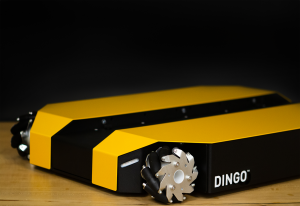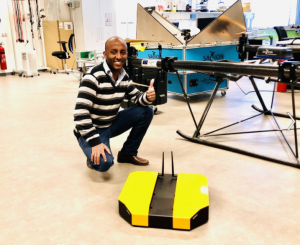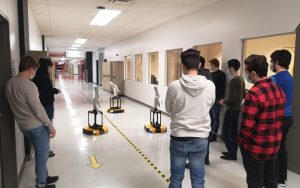Our team often gets asked “How do you integrate more sensors on a Dingo?” “Why not just get the larger Ridgeback omnidirectional platform?”
Dingo, the compact indoor mobile robot, is now packed with even more potential thanks to a top plate system providing increased and completely customizable space for sensor and accessory integrations. Continue reading to learn more about Dingo’s features and enhanced possibilities.
About Dingo
Dingo is a light-weight, compact indoor mobile robot designed for robotics research and education. Available in two drive systems, differential and omnidirectional, with expandable power and computing options, Dingo is ideal for a wide range of robotic applications including autonomous navigation, mobile manipulation and mapping. Dingo offers native ROS and Gazebo integration and is plug-and-play compatible with a wide range of robot sensors and accessories. While great for research applications, its small form factor and relatively low price point makes it ideal for robotics learning and education.


New Top Plate System
Shake things up with the completely customizable top plate and shelf system, taking Dingo’s functionality to new heights by offering more spots than ever to seamlessly integrate various payloads. Cameras, LiDARs, IMUs, screens, and other sensors can all join the Dingo party. Whether it’s research using ROS 2, developing assistive robotics applications, inspecting and surveying indoor environments – and beyond – we cannot wait to see how you Do More with Dingo.
Psst… you can also customize the shelf heights.
Dingo Compared to TurtleBot 4 and Ridgeback
Which automated mobile platform is best for your project? Let’s review some of their key specifications.
|
Dingo |
TurtleBot 4 Standard |
Ridgeback |
|
| Size | 551 x 517 x 110 mm (21.7 x 20.3 x 4.33 in) |
341 x 339 x 351 mm (13.4 x 13.3 x 13.8 in) |
960 x 793 x 311 mm (37.7 x 31.1 x 12.2 in) |
| Payload Capacity | 20 kg (44 lbs) | 9 kg – 15 kg (19.8 lbs – 33 lbs) | 100 kg (220 lbs) |
| Max Speed | 1.3 m/s (2.9 mph) | 0.31 m/s (0.69 mph) | 1.1 m/s (2.4 mph) |
| Ideal Use Cases | Indoor, mapping and surveillance, mobility assistance, educational. |
Indoor, educational. | Indoor, educational and industrial. |
Dingo at Work
Check out some of the various ways our customers have been putting Dingo to work.
Delft University of Technology Advances Compliance Behaviour with Dingo-O Mobile Manipulator
Mobile manipulation and compliant control has become particularly crucial for ensuring robust performance coupled with safety in unstructured, dynamic environments where the robot operates in close proximity to humans. To address these challenges, the Autonomous Multi-Robots Lab at the Delft University of Technology is working on a cost-effective approach to address compliance for mobile manipulators and velocity-controlled mobile bases without having to add force/torque sensors.

Saxion University of Applied Sciences Researches ROS 2 Fleet Management with Dingo
One of the winning teams from our PartnerBot program was Saxion University of Applied Sciences (Academic Category), which was awarded a Dingo-D (differential drive). Their project goal with Dingo is to facilitate the integration of mobile robots into automation ecosystems such as Enterprise Research Planning (ERP) and Manufacturing Execution and Control System (MES) through ROS2 and Navigation 2 integration.

University of Bonn Aims to Enhance Healthcare with Assistive Robotic Mobile Manipulation
Harmony is an EU-funded project that aims to provide a compelling solution to the increased workload on medical personnel with autonomous mobile manipulation robots. The multidisciplinary team aims to provide robust, flexible and safe autonomous mobile robots that can easily be integrated into human-centered environments such as hospitals. Repetitive and time consuming tasks such as on-demand deliveries of materials are mostly performed by nurses. This often hinders their ability to deliver value-added patient care.

ÉTS Fosters Next Generation of Roboticists with Dingo Fleet
The Lab INIT Robots is a research and teaching group aimed at the intuitive and natural control of mobile robotic systems. They conduct research and training activities on path planning, collision avoidance, operator’s ergonomy, robot expressive motion and robot swarm’s control. The lab’s pack of Dingos are being employed in two new courses at ÉTS Montréal. The teaching labs are built over two different scenarios, in order to relate the students’ work to real-world applications.

Next Steps
Don’t underestimate Dingo! Looking for something with more oomph than TurtleBot 4 but don’t need the size of Ridgeback? Whether it’s robotics research or indoor industrial applications, such as monitoring and surveillance, do more with Dingo thanks to the fully customizable top plate and shelf system for all your indoor sensing needs.
Get yours today and request a custom integration on the Dingo webpage.
Even More

